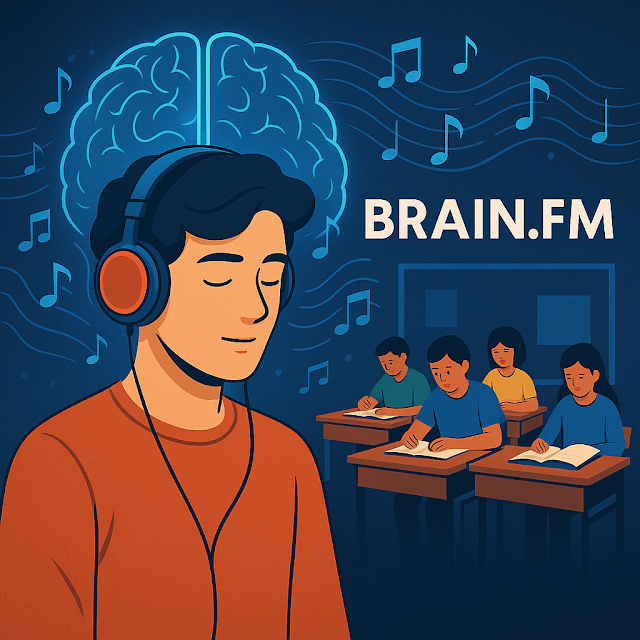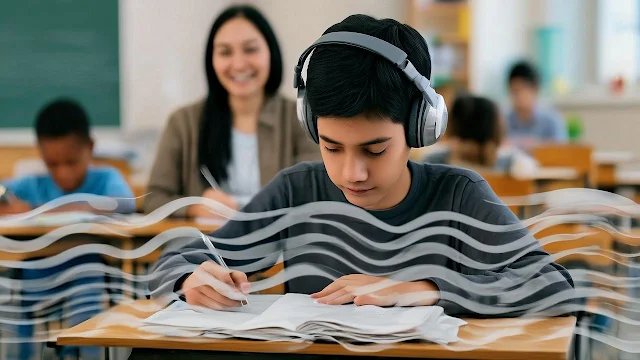Brain.fm: A Real-World Classroom Companion
Introduction: Turning Down the Noise

What Is Brain.fm?
The Science Unplugged
Bringing Brain.fm into the Classroom
Brain.fm isn’t just a solo study hack—it’s a versatile classroom ally. Here’s how teachers can weave it into daily lessons:

-
Math Problem-Solving: Start algebra or geometry sessions with a 10-minute “Focus” track to prime working memory and boost mental flexibility (Tierney & Kraus, 2013).
-
Silent Reading: During independent reading, students use the “Study” mode to create an auditory boundary that minimizes wandering thoughts and sharpens comprehension (Brain.fm Science Page, 2025).
-
Pre-Test Calm: Replace jittery nerves with a quick 5-minute “Relax” break. The slow-wave modulation helps down-regulate stress hormones, making recall under pressure easier (Brain.fm Blog, 2025).
-
Creative Brainstorming: When it’s time to ideate, switch to the “Creative” mode. Subtle rhythmic shifts encourage divergent thinking and keep group discussions flowing (Woods et al., 2025).
-
Sensory-Friendly Zones: In resource rooms, students with ADHD can plug into specialized tracks for non-pharmacological focus support without distracting peers (Woods et al., 2025).
-
Mindful Transitions: After recess or PE, a brief Brain.fm snippet signals a mental reset, easing the shift back into academic work (Brain.fm Blog, 2025).

Pros & Cons: A Balanced View
Pros
-
Evidence-Backed: NSF funding, placebo-controlled experiments, and peer-reviewed studies support its claims (Brain.fm Science Page, 2025; Woods et al., 2025).
-
Tailored Modes: Focus, Study, Relax, Creative, ADHD—each crafted for specific cognitive needs.
-
User-Friendly: No scrolling through playlists—just hit play and let the tracks work in the background.
Cons
-
Subscription Fee: About USD 6–10 per month, which schools need to budget for.
-
Repeat Fatigue: Some students notice familiarity after extended use.
-
Offline Limits: Less extensive offline playback than mainstream streaming services.
Final Takeaways
Brain.fm bridges neuroscience and pedagogy, giving educators an audio scaffold to enhance focus, creativity, and calm. It won’t single-handedly revolutionize learning—but when integrated thoughtfully, it helps students settle their minds, tackle tasks with clarity, and ease test-day jitters. In a classroom full of distractions, purposeful sound might just be the learning lubricant we’ve been missing. (Tierney & Kraus, 2013)
- Brain.fm Science Page. (2025). Our Science. Retrieved from https://brain.fm/science
- Brain.fm Press Release. (2025, January 7). ADHD Music Breakthrough: Peer-Reviewed Study. Communications Biology. Retrieved from https://brain.fm/press/adhd-study
- Brain.fm Blog. (2025). How to Focus Better: Amplify Your Productivity with Music. Retrieved from https://www.brain.fm/blog/how_to_focus_better_amplify_your_productivity_with_music
- Tierney, A., & Kraus, N. (2013). How Musical Training Affects Cognitive Development: Rhythm, Reward and Other Modulating Variables. Frontiers in Neuroscience, 7, 279. Retrieved from https://www.frontiersin.org/articles/10.3389/fnins.2013.00279/full
- Woods, K. J. P., Sampaio, G., James, T., Przysinda, E., Hewett, A., Spencer, A. E., Morillon, B., & Loui, P. (2024). Rapid modulation in music supports attention in listeners with attentional difficulties. Communications biology, 7(1), 1376. https://doi.org/10.1038/s42003-024-07026-3


Comments
Post a Comment